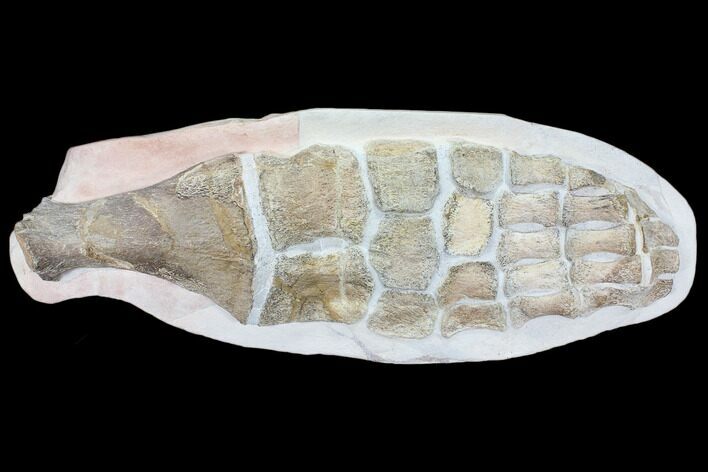This Specimen has been sold.
Giant, 29" Fossil Plesiosaur Paddle - Goulmima, Morocco
This is a HUGE, 29" long, fossil Plesiosaur paddle, from the Upper Cretaceous (Early Turonian Stage) deposits near Goulmima, Morocco. It looks like nearly all of, if not all of the bones are original and were found articulated. There has been some extra rock added around the edges and underneath the piece (pinkish colored limestone) to both for stabilization and aesthetic purposes. There is only some minor restoration along the repaired cracks and then on the two smallest bones at the end of the paddle.
Despite it's huge size, this is actually a partial paddle, it's missing the smaller digits at the end. It appears like they were likely exposed on the surface and weathered away.
It comes with a display stand or we can add a backing and wall hanger upon request.
There are two described Plesiosaurs from this area, and Thililua longicollis appears to be a good potential candidate for the species.
Despite it's huge size, this is actually a partial paddle, it's missing the smaller digits at the end. It appears like they were likely exposed on the surface and weathered away.
It comes with a display stand or we can add a backing and wall hanger upon request.
There are two described Plesiosaurs from this area, and Thililua longicollis appears to be a good potential candidate for the species.
Plesiosaurs were aquatic reptiles. They had small heads, long necks, broad, flattened bodies, short tails and large flippers or paddles. They are one of the best described groups of fossil animals with a total of 110 known species, many from complete or nearly complete fossils. The largest known is Elasmosaurus at 40 feet (12 meters), and the smallest was Thalassiodracon at just under 6 feet (1.5 meters). They first appear in the fossil record near the end of the Triassic Period, starting with Thalassiodracon from about 203 million years ago. They disappear from the fossil record about the time of the Cretaceous-Paleogene Extinction, along with the dinosaurs and most other reptiles.
Plesiosaurs were almost comical in their appearance: small heads full of sharp, cylindrical teeth; wide, comparatively flat bodies; short tails; and four large paddles or flippers. They are so odd-looking that when originally found, the first Plesiosaur fossil was mistaken for a new kid of Pterosaur. Even when the first Plesiosaur went on display, it had its head mounted on the wrong end! Plesiosaur necks could also have large numbers of vertebrae: Albertonectes had 72 in its neck!
Plesiosaurs swam by moving their paddles or flippers in much the same way that modern sea turtles do. This would have made them efficient and maneuverable, but not particularly speedy. Due to their long, thin necks and flippers, it is unlikely that Plesiosaurs left the water. If they did, they would not have been able to travel far. It had long been thought that Plesiosaurs left the water to lay eggs in much the same way as modern sea turtles. Recent evidence seems to prove they bore live young, making theories that they left the water less likely. It is widely held that plesiosaurs were not the fastest swimmers in the sea, cruising to catch their preys of various fish, squid, and other mollusks.
Plesiosaur fossils have been found worldwide. The first described fossil was found in Kansas. Since then, they have been found on every continent. Most commercially available Plesiosaur fossils come from Morocco and Kansas.
Plesiosaurs were almost comical in their appearance: small heads full of sharp, cylindrical teeth; wide, comparatively flat bodies; short tails; and four large paddles or flippers. They are so odd-looking that when originally found, the first Plesiosaur fossil was mistaken for a new kid of Pterosaur. Even when the first Plesiosaur went on display, it had its head mounted on the wrong end! Plesiosaur necks could also have large numbers of vertebrae: Albertonectes had 72 in its neck!
Plesiosaurs swam by moving their paddles or flippers in much the same way that modern sea turtles do. This would have made them efficient and maneuverable, but not particularly speedy. Due to their long, thin necks and flippers, it is unlikely that Plesiosaurs left the water. If they did, they would not have been able to travel far. It had long been thought that Plesiosaurs left the water to lay eggs in much the same way as modern sea turtles. Recent evidence seems to prove they bore live young, making theories that they left the water less likely. It is widely held that plesiosaurs were not the fastest swimmers in the sea, cruising to catch their preys of various fish, squid, and other mollusks.
Plesiosaur fossils have been found worldwide. The first described fossil was found in Kansas. Since then, they have been found on every continent. Most commercially available Plesiosaur fossils come from Morocco and Kansas.
SPECIES
Thililua longicollis?
LOCATION
Goulmima, Morocco
SIZE
Paddle 29" long
CATEGORY
SUB CATEGORY
ITEM
#107318
We guarantee the authenticity of all of our specimens.
 Reviews
Reviews



















